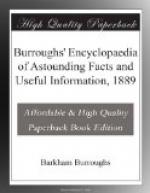Bank-notes are altered in two ways, namely: raising the denomination, and changing the name of a broken to that of a responsible bank.
First, in altering a note, it is scraped until thin: then figures of larger denomination are pasted over. A pasted note may be detected by holding it up to the light, when the pasted parts will appear darker, as they are thicker.
Second, the denomination of a note is raised by taking out a low one with an acid, and printing in a higher one with a counterfeit stamp. The ink used in genuine bank-note printing is a peculiar kind, and not easily to be obtained by counterfeiters: therefore, their printing will not appear as clear and bright as that of the government, which is done with ink of the finest quality. If the ink is black, it gives a clear and glossy impression, without any of that smutty appearance, as is sometimes seen in counterfeit bank-notes. It is almost impossible to imitate the green ink that is used by the government, and it is nearly as difficult to imitate the red and other colors. Counterfeit inks look dull and muddy, while genuine inks have a glossy appearance.
In the case of a note altered by the use of acid, it may be noticed that the acid, by spreading more than was intended by the counterfeiter, has injured parts of other letters, and the paper will appear more or less stained by the acid.
COMPARING AND EXAMINING NOTES.
A counterfeit should be compared with one that is genuine, in order to familiarize one’s self with the distinguishing features which have already been indicated.
It is best to acquire the habit of giving each note as received a searching glance, turning it over to see the back, and if there be any defect, it will probably catch the eye. If there be the least suspicion, a critical examination of all its parts should be made.
In case of doubt, the lathe work should be carefully examined, and it may be compared with a perfectly good bill; then examine the shading around the letters, and search for any sign of alteration in the title or denomination of the note. If there are any medallion heads or shields, notice the lines; if there is any red letter work, designed to appear on both sides, look at the character of the work on the face, then turn the note and examine the back. If the printing is not exactly alike on both sides, but varies in any part the note is counterfeit. Then observe the vignettes and portraits, to see whether their style and perfection compare well with the work on genuine notes. Then examine the solid print and engravers’ names, as well as the printing, ink, and paper. By such thorough examination, one can hardly be at a loss to determine the status of the note.
Good magnifying glasses are necessary, in most instances, to bring out the fine lines on bank-notes. Sometimes a microscope of great power is required to discern the genuine line.




